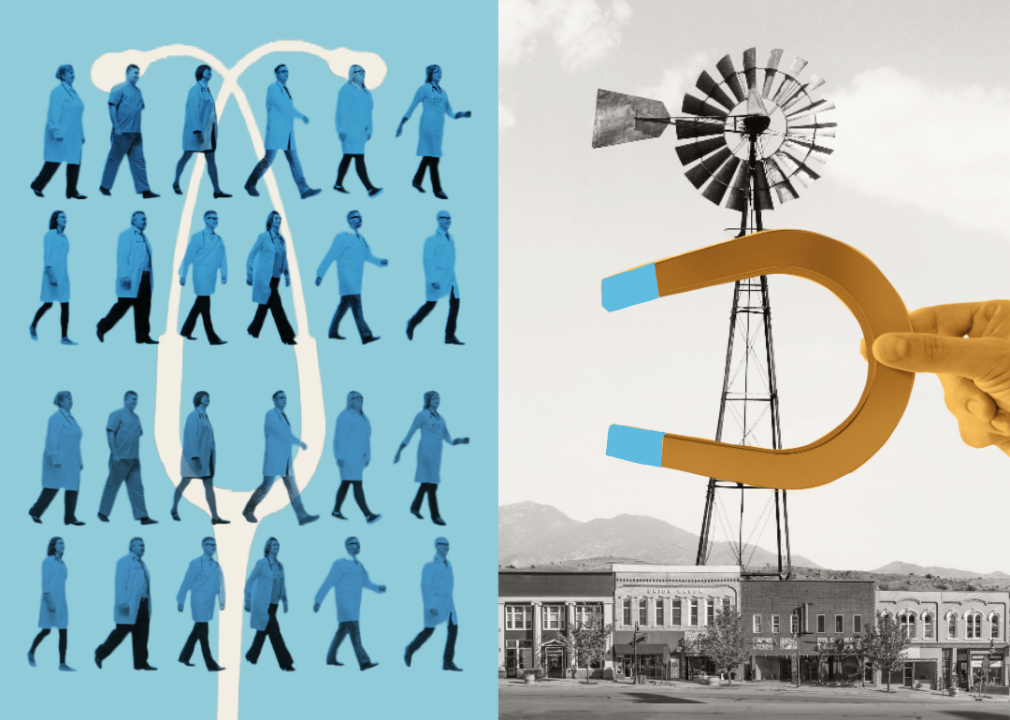Location can impact health more than genetics. These initiatives are improving rural health care access.

Photo illustration by Elizabeth Ciano // Stacker // Shutterstock
Location can impact health more than genetics. These initiatives are improving rural health care access.
A split screen digital illustration; the left side has a white silhouette of a stethoscope in the background with an overlay of rows of doctors walking toward the right-hand photo, which shows a hand holding a horseshoe magnet toward the doctors, with a rural windmill in background.
When it comes to health, our genes mean a lot: They carry our families’ history of diabetes or cancer, make us more susceptible to certain diseases, and impact our blood type. While genetics play a large part in health outcomes, they are only one piece of a complex puzzle. Based on recent examination, it’s clear that what public health experts call the social determinants of health are just as, if not more, influential in determining health outcomes.
Social determinants of health include economic stability, access to and quality of health care and education, social and community context, and environmental and geographic factors.
Living in a rural area intersects with many of these social determinants. There is frequently less economic stability, communities are more spread out, and drives to school are longer. Obstacles to health care access are far more prevalent than in more populated areas. Longer wait times, provider shortages, and fewer resources devoted to health care are several barriers to accessing medical professionals in rural communities. What’s more, fewer people in rural areas have health insurance than their urban and suburban counterparts.
Within rural areas, significant racial and ethnic disparities in health persist. Black and Indigenous Americans living in rural communities face much worse health outcomes than white rural residents due to inequities that impact wealth, access to education, and living and working conditions.
Only 10% of physicians practice in rural areas, though 20% of the U.S. population lives in rural areas, according to 2017 government data. In areas without enough physicians for the population—places designated Health Professional Shortage Areas—existing health issues often go undiagnosed and untreated for longer, emergency medical situations require long commutes, and there are fewer specialists to treat specific issues.
Doctor shortages have long been a part of rural life—medical students and doctors frequently go to school and practice in more heavily resourced urban or suburban areas. For rural patients, this lack of access to medical care can be distressing, frustrating, and psychologically damaging.
Medical schools and state and federal governments have taken steps to remedy these shortages. Hospital Care Compare dove into government data, public health research, and news coverage to investigate the reasons behind rural doctor shortages and how these shortages are being addressed.
Medical schools invest in students with the hopes they’ll put down rural roots
Various recruitment programs and incentives exist to attract physicians to rural areas where doctors are few and far between. Within about 40 medical schools and counting, organizations have created rural training tracks to attract medical students to practice rurally and prepare them adequately for this kind of work.
Part of these programs include outreach before students arrive at medical school—or even prior to them deciding to be doctors. A number of studies have shown that physicians are more likely to practice in rural areas if they come from a rural place, but students with rural upbringings are significantly underrepresented in medical school programs. These programs frequently recruit from rural community colleges and four-year schools to foster interest in medical school and attract more students from rural backgrounds to pursue medicine.
Once in these programs, students have more opportunities to train in rural communities than the average medical student. They complete their rotations and residencies in small communities and learn about the scope of rural practice, often broader than the scope for physicians in urban areas with more specialized practitioners.
In addition to rural-specific tracks and training programs, there are incentives for medical students pursuing rural practice, such as loan repayment programs for doctors. Federally, the National Health Service Corps has a loan repayment program for health care providers working in communities impacted by the opioid epidemic. Certain states also offer similar programs, promising loan repayment or forgiveness in exchange for a certain number of years of service within rural communities.
Another type of incentive aims to attract international medical students attending school in the U.S. to rural areas. These programs, known as J-1 visa waiver programs, allow students to live in the country on J-1 visas and practice immediately in the U.S., waiving the usual requirement that they return to their home country for at least two years—as long as they practice rurally in a designated Health Professional Shortage Area.
Although these programs are sometimes effective in getting physicians to rural areas, evidence is scant regarding the success rates of keeping them there.
According to a 2023 review of rural physician recruitment programs and incentives, little is known about the retention of doctors practicing in rural communities, and minimal resources and incentives remain available for doctors who stay in rural positions. Many physicians leave rural areas once they have completed incentives or service commitments, often leaving communities in a similar situation as they started.
Existing information about rural health care providers points to the importance of adequate preparation for rural practice and small-town living, as well as strong community bonds to keep physicians rooted in rural areas. Studies show that preparing doctors for a rural lifestyle, as well as giving them rural rotations, can improve retention rates. Integrating doctors into the communities they serve through nonwork-related engagement can also boost the likelihood of providers staying put in rural areas.
Story editing by Alizah Salario. Additional editing by Kelly Glass. Copy editing by Kristen Wegrzyn.
![]()
This story originally appeared on Hospital Care Compare and was produced and distributed in partnership with Stacker Studio.